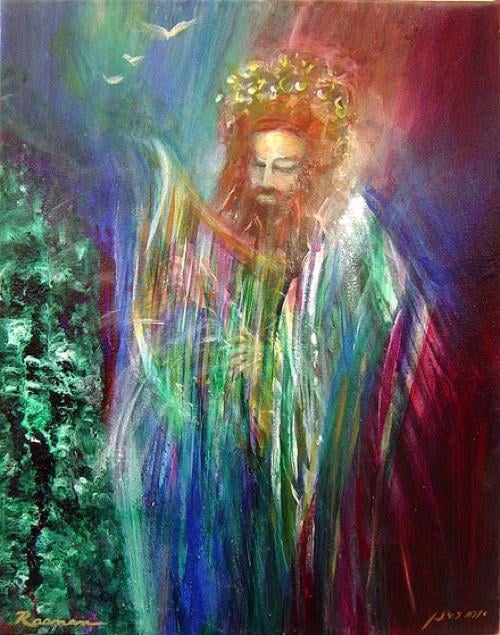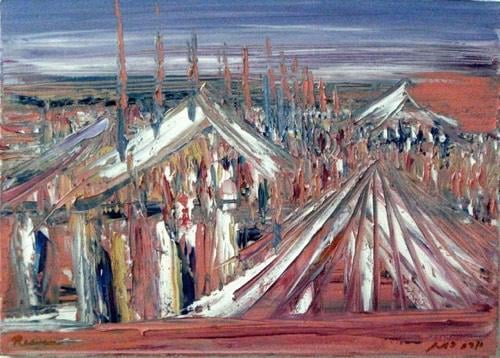The Code of Jewish Law clearly states that a child of a Jewish mother is Jewish, regardless of the father’s lineage (or whatever else may show up in a DNA test), while the child of a non-Jewish mother is not Jewish.1 Matrilineal descent has been a fundamental principle of Torah since the Jewish people came into existence.
(If your father is Jewish, but not your mother, please see To a Child of a Jewish Father.)
Some aspects of Judaism, like the priesthood, are clearly patrilineal (see Patrilineal Descent in Judaism, below). But the entry line into Jewishness has always been through the mother—or conversion.
Biblical Roots of Jewish Matrilineal Descent
There’s clear evidence There’s clear evidence of the rule of matrilineal descent in Biblical times in the story of Ezra and the returning exiles.of the rule of matrilineal descent in Biblical times in the story of Ezra and the returning exiles.
The Book of Ezra tells the story of the Jews who returned from Babylonia to finish rebuilding the Holy Temple in Jerusalem. Upon their arrival they found that many of the Jews who inhabited the land had taken non-Jewish wives.
Ezra was heartbroken, tearing his garments in mourning and prayer to G‑d. A large crowd gathered, and joined with Ezra as he prayed and wept.
Next, the verse states:
And Shechaniah, the son of Jehiel, of the sons of Elam, raised his voice and said to Ezra, "We have betrayed our G‑d, and we have taken in foreign wives of the peoples of the land, but there is still hope for Israel concerning this.”
“Now then, let us make a covenant with our G‑d to expel all these women and those who have been born to them, in accordance with the bidding of the Lord and of all who are concerned over the commandment of our G‑d, and let the Torah be obeyed.”2
If the child of a Jewish father is Jewish, why did Shechaniah suggest expulsion of the children born to these women? How was it that Ezra and all the people agreed to his advice? Jewish people historically were greatly attached to their children. How is it that they agreed to send them away?
Obviously, it was a given that these children were not Jewish. Furthermore, note that Shechaniah states, “and let the Torah be obeyed.” Apparently, everyone understood that this was not a new edict, but a call for obedience to the Torah as it had always been understood by the Jewish people.3

Matrilineal Descent in the Times of Moses
Ezra is one of the last books of the Hebrew Bible. Many have asked why this issue was not raised earlier—even in the times of Moses?
If the Hebrew Bible provided a detailed exposition of every law and custom, this would be a question. But with even a cursory look it’s obvious that this is not so. Some laws, such as priestly rites and offerings, or the design and artifacts of the Tabernacle are described in detail. Others—generallyThe most common laws are presented with no specifics at all. the most common ones—are presented with no specifics at all.
For example, we are told to “rest on the seventh day” and “do no work.”4 What is rest? Are we meant to sleep the entire day? What is work? Does it mean exertion, or productivity, or just anything not enjoyable? The few details that the text provides are of little help. (“Don’t burn fire in your dwellings.”5 “No one should move from their place.”6)
Moses is told that we are to slaughter an animal “… as I commanded you.”7 But nowhere are we provided the details of just what Moses was instructed.
So why are some details provided and others left out?
One possible answer is that it is only necessary to commit details to writing that are easily forgotten. Those matters that all the people are intimately familiar with are left to be passed down organically and tacitly.
But whatever the reason, the fact that there is no explicit verse stating which parent makes you Jewish is not unusual.

The Earliest Reference to Matrilineal Descent
Rabbinic tradition, then, is that at least from the time that the Torah was given, Jewishness has followed the mother. As we’ve seen, Ezra and his scribes had the same tradition.
In the Talmud,8 we find that Rabbi Shimon bar Yochai provides support for the rule of matrilineal descent from a passage in Deuteronomy. However, this has been widely misunderstood.
Rabbi Shimon did not derive this rule from a passage in DeuteronomyRabbi Shimon did not derive this rule from a passage in Deuteronomy. It was an uncontested tradition long before. He only sought a scriptural allusion. alone. As we can see from Ezra, it was a long-standing tradition that Jewishness is received from the mother. But since we know that every such tradition must be somehow reflected within the written word of the Five Books of Moses, Rabbi Shimon sought an allusion to this tradition as well. And he ingeniously found something quite compelling.
In Deuteronomy 7:4, the generation that is about to enter the Land of Canaan is told:
You shall not intermarry with them; you shall not give your daughter to his son, and you shall not take his daughter for your son. For he will turn away your son from following Me, and they will worship the gods of others, and the wrath of G‑d will be kindled against you, and He will quickly destroy you.9
Read those verses carefully. G‑d is warning the people not to intermarry with the people of the land they are about to enter. Neither their sons nor their daughters should intermarry.
What would you expect next? “For he will turn your daughter away from Me.” Or “She will turn your son away from Me.”
But that’s not what He says. “He will turn your son from following Me.”
Who is that son? Who is the “He” that is turning that son away?
There are only two possible interpretations, and both lead us to the same conclusion.
One possibility is that this is speaking of the son of your daughter—since grandsons are often called sons in the Hebrew Bible. She is the one mentioned first in the verse, who was taken by a non-Jewish man. That is the “he” that is turning that grandson away. But that grandson is still considered your son.
That being so, we see that the child of a Jewish woman, even when the father is not Jewish, is still considered Jewish—”your son.”10
The other possibility is that this is speaking of your son, the one who took a non-Jewish woman. The “he” that is turning him away is his non-Jewish father-in-law. By marrying out of the Jewish people, your son has been turned away from G‑d, because his children will not be Jewish.11
Either way leads to the same conclusion: The child of a Jewish mother and a non-Jewish father is considered Jewish. There is no dissident opinion.12
Is it possible to read these verses differently than either of these two readings? Perhaps. Yet the Talmud does not offer any contention to Rabbi Shimon’s exegesis. To anyone who has studied Talmud, that itself is a stunning fact. The Talmud is replete with contending opinions over almost everything. The fact that on the issue of maternal lineage, there is one opinion, universally accepted, is nothing less than astonishing.
Unless you accept that this had always been the understanding of all Jews.13

Did Moses Marry Out?
Here’s another common question: We see many figures in the Hebrew Bible that married out of their people. Joseph married an Egyptian woman. Moses married a Midianite.14 King David took a Philistine wife and King Solomon also took wives who were not from the Jewish people. Why is there no mention of any conversion?
But then, neither is there any mention of Divine admonition for these intermarriages. For Joseph and Moses, we can answer simply that they were married before the Torah was given. The prohibition of marrying out did not yet exist. But for David and Solomon, that answer does not work. Besides, the story of Pinchas and the Midianite women also makes it quite clear that this sort of union was divinely prohibited.
If there was no conversion and a clear abrogation of divine law, where is the outrage in the text?
Again, the conundrum arises by expecting too much of the text.Again, the conundrum arises by expecting too much of the text. The conversion process was simply obvious to the reader and therefore not worthy of mention.
After all, what was involved? A woman would have to immerse in a mikvah (ritual bath) and accept the covenant before three Jews. A man would require a circumcision. When possible, an offering was brought to the Temple. Ritual immersion, circumcision, offerings—these were all everyday practice for all Jews to be taken for granted.
Here’s an analogy:
Let’s say we would write, “And then Vicki York went to Harvard and received her doctorate in sociology.” We don’t need to write that Vicki wrote a thesis and defended it; the contemporary reader understands that as obvious.
Similarly, it would be superfluous for the Hebrew Bible to account all the details of how any person became part of our covenantal people. The reader, being a member of that covenant, understands.

Is Matrilineal Descent Reasonable?
There are many things in Jewish tradition that are hard to understand. The Five Books of Moses provide many instructions, but rarely provides the “why.” And even the explanations that we do have are not the ultimate reason, as Rabbi Schneur Zalman of Liadi explains. We’re speaking, after all, of the wisdom of our Creator. It’s wondrous that we understand anything at all.15
Nevertheless, Not only is matrilineal descent perfectly reasonable, it’s absurd to imagine otherwise.in this instance, writes the Rebbe, Rabbi Menachem M. Schneerson, of righteous memory, not only is matrilineal descent perfectly reasonable, it’s absurd to imagine otherwise.16
Let’s start with a simple question: To which parent is the child more biologically connected?
Yes, the father provides half the chromosomes. But there’s more to a person than two sets of chromosomes.
An embryo must sit within its mother’s womb and develop for nine months. During those months, the fetus is nurtured from the bloodstream of the mother, affected by her emotions, by the sounds she hears and the places she goes.17 And none of this, especially the birthing process, is a terribly comfortable experience for the mother.
This aside from the nursing and nurture, both physical and psychological, in the primary years that are most critical to the child’s development. Generally, that’s provided by the mother, who is capable of providing far more than the man.
Now, ask yourself, to whom would you give dominance in the fundamental identity of this child? Is it justified to ignore the woman’s role, and identify the child after the father? If the mother is, say, Cherokee, determining that the child is Jewish because the father is Jewish is in conflict with the basics of biology.18
The Rebbe sharply criticized those who insist we change Jewish law and accept patrilineal descent. Firstly, he said, they cannot succeed. Torah law does not change, and every attempt to make changes of this sort has failed in the long run.
But aside from that, these people do not realize what they are playing with. Each human being is created with a role in this world that is tied to their identity. To tell a person that he is Jewish when he is not is a crime against both mother and child. It is robbery in the worst sense to steal away a person’s identity and the fundamental meaning of their life.
That’s a point many who argue for patrilineal descent ignore. They argue that we must have compassion, that we must be more inclusive, and we should open the doors of Jewishness to those who have either a mother or father who is Jewish. Why demand a conversion in these cases?
But this argument ignores not only the fundamental makeup of the child, but the dignity of the mother of the child, as well as women in general. “I would have expected all the women of the world to protest,” the Rebbe said.
And it is extremely ethnocentric, as though Jewish identity exists in a vacuum. There are people in the world besides Jews, and they also have identities. By simple biological fact, that identity principally follows the mother.
(Click here for more on the Jewish Mother.)

Patrilineal Descent in Judaism
Although Jewishness is matrilineal, there are many aspects of Judaism that are patrilineal.There are many aspects of Judaism that are patrilineal. But this too is eminently sensible.
For example, within the Jewish people there is a division of Yisrael, Levi and Kohen. And that’s patrilineal.
The Kohen, as long as the Jewish Temple is standing in Jerusalem, must take care of the offerings and services and live in ritual purity. The Levi is there to assist the Kohen. Someone has to go to work for six days and rest on the seventh, so that’s the rest of us—Yisroel.
How does a child know if he or she is a Kohen, Levi or Yisroel? That goes by the father. That’s what I meant when I said that Judaism is patrilineal, even though Jewishness is matrilineal.
There are other things in Jewish law that principally follow the paternal line—tribal rights, inheritance, and more. We don’t need to get into them here. Let’s keep to this question: Why the difference between determining whether you’re a Jew and whether you’re a Kohen? Once we answer that, many other questions will fall away.
The Rebbe also explained this in simple terms: These are secondary identities. They are less about who you are and more about how you are expected to be.
A kohen must learn to be extremely careful about what he eats, where he goes and how he behaves. He must learn how to do his job in the Temple. These are things a child learns a little later—and principally from his father, the one most involved in these duties.
The same applies to the Levi, who is singing in the Temple, guarding the gates, and performing other duties. And the same with this Yisrael, who must do his work and provide for the Kohen and the Levi.
So, quite sensibly, the primary identity of a child comes from the mother. The secondary identity, related more to duties and role, come from the father, who is responsible to educate and provide a role model for the child in these matters.

Jewish Resilience
It’s vital to understand that Judaism is not a Judaism is not a book.book. Judaism is the covenant of a people with G‑d. The story of that covenant and its basic tenets is preserved in written form in what people call the Hebrew Bible. The way the people understood that covenant and its details was preserved by oral tradition for many centuries until it was slowly committed to writing.
This is crucial to know, because otherwise you might find yourself doing very strange things. Moses tells the people that no one is to leave their place on the seventh day.19 You will likely find that quite difficult—until you learn that the oral tradition understands this not as literally as you may think.
G‑d tells Moses, “An eye for an eye, a tooth for a tooth.”20 That could lead to a blind and toothless society—were it not for the oral tradition that this is an idiomatic expression referring to fair monetary compensation (as stated explicitly elsewhere).
Other instances abound. The point is that, yes, it is possible to read the written word and interpret matters in multiple forms. There was actually a sect—some still survive—called the Karaites, who relied entirely on their own literal understanding of the text and denied the existence of any oral tradition. They believed that the Torah was purely patrilineal. But then, they also refused to accept converts, since they saw no basis for such in the written text either.21
The Judaism that has proven sustainable, vigorous and youthful to the present day relies on a rigorous faithfulness to an accumulative oral tradition, which in turn proves itself consistent with the written word. And that Judaism has always stated without equivocation that Jewishness follows the mother.












Join the Discussion